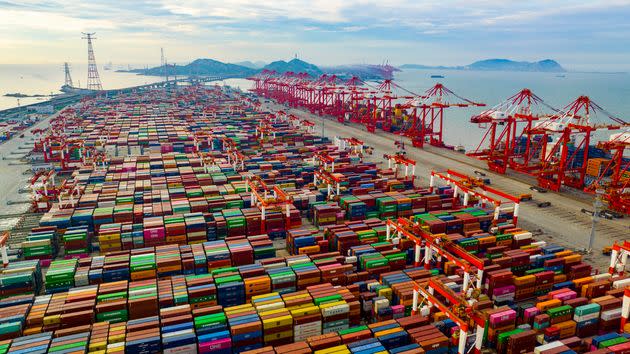China Restricts Exports Of A Key Mineral, Stoking U.S. Fears About Battery Supply Chains

A number of very large container ships carry out container handling operations at the automated terminal of Yangshan deep-water Port, Shanghai, China, July 21, 2023.
China has slapped export controls on graphite, a key mineral used to make steel and electric car batteries, ratcheting up a trade fight with the United States over the technologies needed to wean the world’s economy off planet-heating fossil fuels.
The measures, announced Friday in a joint declaration from Beijing’s Ministry of Commerce and the General Administration of Customs, banned exports of artificial graphite, the natural flake version of the mineral, and products made with them unless the government grants permission. The restrictions take effect on Dec. 1.
“Graphite is a key material that holds strategic significance in new-energy industry and global players are fiercely competing with one another in this sector,” Tian Yun, an economist in Beijing, told the Chinese nationalist newspaper Global Times. “It can be expected that similar moves will be more commonplace if the US continues to escalate sanctions in the technological field against China.”
The restrictions come as President Joe Biden has expanded the Trump administration’s trade war with China, placing export bans on technologies like the semiconductors needed to power artificial intelligence applications. The Biden administration is set to ramp up tariffs on Chinese-made solar equipment as Beijing provides its own factories with so much government support that even dairy companies are opening factories to churn out the materials for panels. In response, China in July put new export controls on two metals used to make computer chips and solar panels, gallium and germanium.

Employees work on the production line of lithium batteries at the workshop of a new energy lithium battery industrial park on Aug. 28 in Yichang, Hubei Province of China.
As with so many of the minerals required to make batteries, solar panels and other crucial energy hardware, China is the world’s top producer and exporter of graphite, generating 65% of the global supply and nearly 90% of the battery-grade version. The U.S. is the largest importer, followed by its allies in the European Union and South Korea, with whom Washington is now increasingly competing as America’s demand for graphite has grown in the past five years. Imports for consumption in the U.S. surged by more than 50% from 2021 to 2022, according to U.S. Geological Survey data.
Yet the U.S. mines none of its own graphite. Three U.S. companies are looking to develop graphite mines in the U.S., two in Alabama and one in Alaska. In July, the Biden administration offered $37.5 million through grants issued via the Cold War-era Defense Production Act to boost the Alaskan project and support a processing facility in Washington state.
But demand is only expected to grow as funding from the Inflation Reduction Act, President Joe Biden’s landmark climate-spending law, spurs more automakers and battery companies to open factories in the U.S.
“Virtually every lithium-ion battery chemistry uses graphite for its anode. China processes 90% of the world’s battery grade graphite. China has put export controls in place to protect national security,” Jay Turner, an environmental policy historian and author of a recent book on battery supply chains, wrote in a post on X, formerly Twitter. “Welcome to the new geopolitics of the clean energy transition.”
As the U.S. and its allies seek alternatives to China for various so-called critical minerals, the rush for graphite could put a new focus on countries in Africa. Madagascar, Mozambique and Tanzania have large reserves and increased mine production significantly from 2021 to 2022. The two countries with the largest reserves outside China are Brazil and Turkey, but mining increased only marginally in both places during that same period.
The trade fight with China has spurred calls to mine and refine more metals in the U.S. But efforts to permit new mines have foundered as local opponents, fearful of the effects on water tables and general pollution, seek to block the permits at various levels of government.
China’s dominance over the global supplies of critical minerals first came to light in 2010, when Beijing blocked shipments of rare earths, over which it enjoys a near monopoly, to Japan over a political dispute. While the U.S. and its allies have been slow to prioritize domestic mining and processing, China has continued to increase its share of global production and deepen ties with other major producers in Africa and Asia.
Reluctant to simply become exporters of raw ore, which typically offers a minimal economic boost while generating a lot of pollution, many countries are now putting more government controls over mining, including creating incentives for Chinese, American and European companies to set up local processing plants.
CORRECTION: An earlier version of this story incorrectly referred to graphite as a metal. It is an allotrope of pure carbon, and a non-metal.
